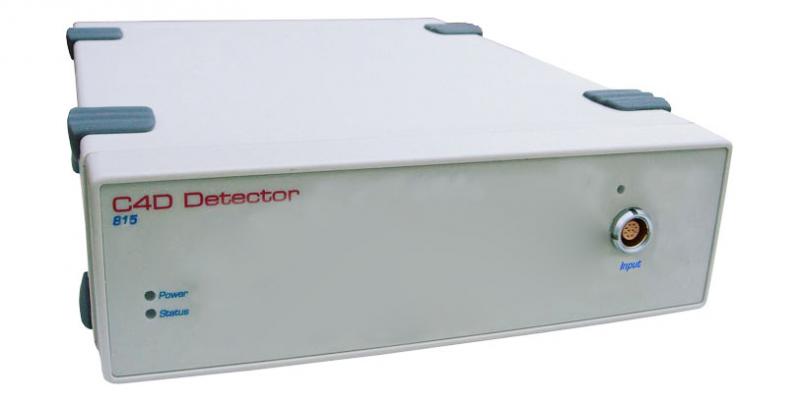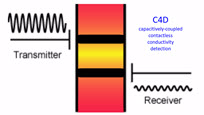ER815 Contactless Conductivity Detector

ER815 Contactless Conductivity Detector
- For electrophoresis and chromatography techniques
- Works with both eDAQ and third-party software
- Wide settings range for optimum conductivity detection
The ER815 C4D Detector is a high sensitivity capacitively-coupled contactless conductivity detector (C4D). This single channel system can be used for capillary electrophoresis, microchip electrophoresis, ion chromatography/HPLC, flow injection analysis and novel applications.
The excitation frequency and amplitude can be optimised by the user for maximum signal sensitivity. The unit must be used together with an eDAQ C4D headstage suitable for your application.
The ER815 is available in the following configurations, depending on your application:
- ER815R: includes PowerChrom software, for capillary electrophoresis, microchip electrophoresis and chromatography-type applications.
- ER815C: includes Chart software, for flow injection analysis and conductivity monitoring applications.
- ER815: for people wishing to use third-party software to record the data. This includes ChemStation from Agilent, 32 Karat from Beckman Coulter and LabVIEW (using the virtual serial interface over USB connection to computer). In this configuration, the ER815 provides both analog and serial data output.
Users can change the configuration of their ER815 themselves at any time, from using eDAQ software to third-party software or vice-versa, using the ER8x5 Converter and Updater software.
The product comes with the following software included: C4D Profiler V2 (to optimise the settings), C4D Configurator (to select the settings) and ER8x5 Converter and Updater (to change the firmware).
The ER825 C4D Detector is a multi-channel version of the single-channel ER815. The ER825 can record the conductivity at up to eight positions on a capillary or tubing.
Trigger cable if required must be ordered separately: EC073 BNC termintion or EC074 Tinned ends
Research Areas
- Capillary Electrophoresis
- Chromatography
- Conductivity
- Flow Injection Analysis FIA
- Microchip Electrophoresis
Technical and Application Notes
Technical Notes
- Connecting the C4D to the Agilent 1600 CE
- Connecting the C4D to the Beckman Coulter CE
- Connecting the C4D to the PrinCE
- Connecting the C4D to the Agilent 7100 CE
- Connecting the C4D to the WynSep Wyn-CE
- The eDAQ 150 micron C4D headstage
- C4D for Ion Chromatography with the ET125 Headstage
- Procedure for Microchip Electrophoresis with C4D
- Procedure for Microchip Electrophoresis with C4D with the ET121
- Procedure for Capillary Electrophoresis with C4D
- Appropriate Frequency to use with Different Background Electrolytes and Capillary Inner Diameters
Application Notes
- C4D Analysis of Acetylchorine Chloride on a Prince CE System
- Analysis of Inorganic Cations by CE-C4D
- Anions by MCE-C4D
- Electro-osmotic Flow Measurement in a Microfluidic Chip
- Simultaneous Analysis of Anions and Cations in Drinking Water by CE-C4D
- Measuring Total Dissolved Inorganic Carbon of Seawater using Flow Injection Analysis and C4D
- Measuring the Conductivity of Melt Water from Arctic Ice Cores
- Measuring the Conductivity of a Liquid in a Pipette Tip
Citations
- Gas Diffusion Cell Geometry for a Microfluidic Dissolved Inorganic Carbon Analyzer. Philip J. Bresnahan and Todd R. Martz. Ieee Sensors Journal, 18, 2211-2217, 2018. DOI: 10.1109/jsen.2018.2794882
- Quantitative Characterisation of Conductive Fibers by Capacitive Coupling. Andres Ruland, Rouhollah Jalili, Attila J. Mozer, and Gordon G. Wallace. Analyst, 2017. DOI: 10.1039/C7AN00442G
- Clinical screening of paraquat in plasma samples using capillary electrophoresis with contactless conductivity detection: Towards rapid diagnosis and therapeutic treatment of acute paraquat poisoning in Vietnam. Anh Phuong Vu, Thi Ngan Nguyen, Thi Trang Do, Thu Ha Doan, Tran Hung Ha, Thi Thao Ta, Hung Long Nguyen, Peter C. Hauser, Thi Anh Huong Nguyen, Thanh Duc Mai. Journal of Chromatography B, 1060, 111–117, 2017. DOI: 10.1016/j.jchromb.2017.06.010
- Microfluidic Breadboard Approach to Capillary Electrophoresis. Israel Joel Koenka, Jorge Sáiz, Paul Rempel and Peter C. Hauser. Analytical Chemistry, 88, 3761−3767, 2016. DOI: 10.1021/acs.analchem.5b04666
- Electric field-driven extraction of lipophilic anions across a carrier-mediated polymer inclusion membrane. Hong Heng See, Peter C. Hauser. Analytical Chemistry, 83, 7507-13, 2011. DOI: 10.1021/ac201772g
- Optimization of capillary electrophoresis method with contactless conductivity detection for the analysis of tobramycin and its related substances. Mohamed N. El-Attug, Jos Hoogmartens, Erwin Adams, Ann Van Schepdael. Journal of Pharmaceutical and Biomedical Analysis, 58, 49–57, 2012. DOI: 10.1016/j.jpba.2011.09.032
- Capillary electrophoresis with capacitively coupled contactless conductivity detection for the determination of cis/trans isomers of octadec-9-enoic acid and other long chain fatty acids. Yong Foo Wong, Bahruddin Saad, Ahmad Makahleh. Journal of Chromatography A, 1290, 82-90, 2013. DOI: 10.1016/j.chroma.2013.03.014
- Referenced Capacitively Coupled Conductivity Detector for Capillary Electrophoresis. Marko Stojkovic, Boris Schlensky, Peter C. Hauser. Electroanalysis, 2013. DOI: 10.1002/elan.201300413
- The analysis of small ions with physiological implications using capillary electrophoresis with contactless conductivity detection. Ioan-Ovidiu Neaga, Bogdan Cezar Iacob, Ede Bodoki. Journal of Liquid Chromatography & Related Technologies, 2014. DOI: 10.1080/10826076.2013.825862
- Study on urinary metabolic profile of phenylketonuria by micellar electrokinetic capillary chromatography with dual electrochemical detection. Dongli Zhang, Wenli Li, Junbo Zhang, Wanrong Tang, Chenxu Qian, Minghao Feng, Qingcui Chu, Jiannong Ye. Analytica Chimica Acta, 2011. DOI: 10.1016/j.aca.2011.03.044
- Flow injection determination of free fatty acids in vegetable oils using capacitively coupled contactless conductivity detection. Ahmad Makahleh, Bahruddin Saad. Analytica Chimica Acta, 694, 90–94, 2011. DOI: 10.1016/j.aca.2011.03.033
- Determination of creatine and phosphocreatine in muscle biopsy samples by capillary electrophoresis with contactless conductivity detection. Hong Heng See, Julia Schmidt-Marzinkowski, Worapan Pormsila, Réjane Morand, Stephan Krähenbühl, Peter C. Hauser. Analytica Chimica Acta, 727, 78-82, 2012. DOI: 10.1016/j.aca.2012.03.055
- Determination of underivatized long chain fatty acids using RP-HPLC with capacitively coupled contactless conductivity detection. Ahmad Makahleh, Bahruddin Saad, Gan Hui Siang, Muhammad Idiris Saleh, Hasnah Osman, Baharuddin Salleh. Talanta, 81, 20-24, 2010. DOI: 10.1016/j.talanta.2009.11.030
- Capacitively coupled contactless conductivity detection as an alternative detection mode in CE for the analysis of kanamycin sulphate and its related substances. Mohamed N. El-Attug, Erwin Adams, Jos Hoogmartens, Ann Van Schepdael. Journal of Separation Science,34, 2448–2454, 2011. DOI: 10.1002/jssc.201100267
- Simultaneous determination of atenolol and amiloride in pharmaceutical preparations by capillary zone electrophoresis with capacitively coupled contactless conductivity detection. Khaldun M. Al Azzam, Bahruddin Saad, Hassan Y. Aboul-Enein. Biomedical Chromatography, 24, 948-53, 2010. DOI: 10.1002/bmc.1390
- Monitoring of nitrite, nitrate, chloride and sulfate in environmental samples using electrophoresis microchips coupled with contactless conductivity detection. Camilla Benevides Freitas, Roger Cardoso Moreira, Maria Gizelda de Oliveira Tavares and Wendell K. T. Coltro. Talanta 147, 335–341, 2016. DOI: 10.1016/j.talanta.2015.09.075
- Determination of Major Inorganic Ions in Solution of the Nutrient Film Technique Hydroponic System by CZE with Capacitively Coupled Contactless Conductivity Detection. Takato Hasebe, Chisaki Hiroshima, Ryota Azuma, Mitsuru Abo. Bunseki kagaku 65(5):283-288, 2016. DOI: 10.2116/bunsekikagaku.65.283
- Channels: 1
- Input connector: 10 pin LEMO (for C4D) or DIN (for other detectors)
- Signal gain: x1, x10, x100
- Analog signal resolution: 16 bits (Chart software), 24 bits (PowerChrom software)
- Virtual serial port resolution: 24 bit
- Input gain ranges: ±20, 50, 100, 200, 500 mV ±1, 2, 5 V
- Excitation frequency: 20 — 2000 kHz
- Excitation amplitude: 1 — 20 V AC p-p, sinusoidal, @ <50 mA
- Offset: ±5.5 V on ±10 V output range
- Low pass filters: 1000 (off),10, 1 Hz
- Output signals: ±5 V max, or USB with virtual serial interface
- Back panel connectors: BNC (analog voltage), USB (virtual RS232 serial)
- Trigger input from a Contact closure or TTL; Trigger cable can be ordered separately
- Power requirements (mains adaptor supplied): 12 V DC, ~10 W
- Dimensions (h × w × d): 65 × 200 mm × 250mm (2.6 × 7.9 × 9.8”)
- Weight: 1.8 kg (4.3 lb) maximum
- Operating temperature: 0 to 35 °C
- 0 to 90% humidity (non-condensing)
- The optimum excitation frequency and amplitude can be measured using the C4D Profiler V2 software.
-
The excitation frequency and amplitude can be set by using:
- When serial firmware is installed: use C4D Configurator software.
- When applications firmware is installed: use the option in PowerChrom or Chart software. - The firmware can be changed by the user at any time, between serial firmware (signal recorded in third-party software) and applications firmware (signal recorded in eDAQ software), using the ER8x5 Converter and Updater software.
More Information
![]() ER815_C4D_Detector
(270 KB PDF)
ER815_C4D_Detector
(270 KB PDF)
Also see:
ER825 Multi-Channel Contactless Conductivity Detector
ET120 C4D Headstage for Capillary Electrophoresis
ET125 General Purpose C4D Monitor Headstage
ET130 IC/HPLC C4D Detector Headstage





